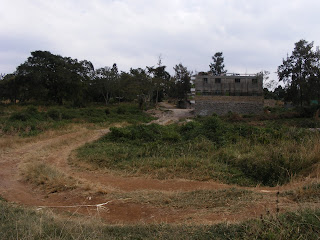Friday, after class let out at 12:45, we went to town to see a photography exhibit at the Nairobi Gallery. On the way we stopped for Ethiopian at Club Soundd. It was good for the crazy cheap price, and had delicious potatos that were sort of like french fries but in more of a potato form. I've never had them at any Ethiopian place, but Kenyans are fairly obsessed with potatoes, so they must be catering to their customer.
We left Maria at a coffeeshop, and went to the exhibit. Later, I got a text from Maria saying her waitress said some guy asked her for her number. Kenyan men are something else, but it can be hilarious sometimes. Almost all sign are handpainted in city center, often faded, crumbling, cracked. The ticketbooth we went to for our tickets into the museum was a dark booth with idle men surrounding it. It didn't really look in operation at all, and there were no other people at the museum, so we were wary of giving them money, but they had tickets so we did. One of the idle men held out his hand when we walked up, so I took it, and he says, "Look! I'm with a mzungu!" and everyone laughed. Typical, but funny. I prefer it when they make a joke to when they just point and say "mzungu" or yell it repeatedly to get my attention. They succeed, of course, because people say it enough that it does practically become your name, but I'd rather it not.
The museum is next to the Nyayo House where they used to torture detainees and political prisoners under Moi, which is ironically named after Moi's supposed philosophy of peace, love, and unity. It's still a government building.
The museum was small with an interesting layout. You walked down a hallway into an atrium with maybe eight doors covered by black curtains. Every single door and window was covered by a black curtain, but some of the doors were closed, so you'd push aside the curtain and not actually be able to go through. Inside the rooms behind the curtains it was dark with more curtain-covered windows and doors to fool you. It was like a dream.
Each room had one or two projectors scrolling photos by one of seven Kenyan photographers, meant to show different perspectives on the country. There were a few photographers I really loved. One did a collection called "Nairobi Nightlife" which contrasted the vibrant singers and danceclubs in Nairobi with the poor warming themselves by fires by the side of the road, and children sleeping on the street.
This is the advertisement used for the exhibit, and another one of my favorite photographers from it. He took photos of Nairobians wearing glasses handmade by a local artist from recycled materials. There were beautiful high fashion sort of photos, and photos of regular people, and smiling people, and old people, etc.
The third that I loved was called "Colors and curves," and was very artistically done with partial pictures highlighting the curves and geometry of the human form holding a child, buying groceries, etc, and the diversity of colors.
There was another called "Concrete Crystals" in which the photographer used an algorithm to expose the complex and beautiful geometric shapes of Nairobi architecture.
After the gallery, I went to Sarit Center for coffee and to get some work done on my laptop with the free wireless. Dennis joined me when he got off work, and announced that we would be going to town. So, exhausted, I had another cup of coffee.
It's really annoying when people come over, because they're not allowed in after 9:30 pm unless you've gotten permission beforehand, and they make them put down a ton of information on a sign in sheet, and leave their id with the security guards. It's awkward, because they pretty much only make Africans leave their id. They don't know all of our faces. They just assume we live there when we walk up to the gate and let us in because you're white. You can get away with a ton here by being white.
The guards also sleep every single night, so you have to have your cabdriver wait and honk while you knock and literally yell at them over the gate.
Anyway, we ended up going to Simmers. It's outdoors under tents in city center, which was very pleasant. The music was a live Congolese band, I think, and there were great dancers. I was the only mzungu. I've been told that's where all the prostitutes who cater to African men go, but there are prostitutes everywhere you go here.
Then we went to another place... but I don't remember what it was called. It was upstairs with great dancing, great African music. I think I was the only mzungu there, but Dennis says he saw some Italians.
All in all, another great Nairobi night.



































